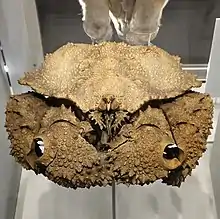Brown box crab
The brown box crab (Echidnocerus foraminatus) is a king crab that lives from Prince William Sound, Alaska to San Diego, California,[1] at depths of 0–547 metres (0–1,795 ft).[2] It reaches a carapace length of 150 millimetres (5.9 in) and feeds on bivalves and detritus. The box crab gets its name from a pair of round tunnel-like openings that form between the claws and adjacent legs when the animal folds its limbs up against its body.[3] Both claws, and their adjacent legs, have matching half-circle notches in them that line up to create a circle-shaped opening when the limbs are tightly pulled against one another.[4] This tubular round opening is called a foramen. The crab often lies buried in the sediment, and the two foramens in the chelipeds allow water into the gill chamber for respiration.[1] The gill chamber is also sometimes used by the commensal fish Careproctus to hold its eggs.[5]

| Brown box crab | |
|---|---|
.jpg.webp) | |
| Scientific classification | |
| Domain: | Eukaryota |
| Kingdom: | Animalia |
| Phylum: | Arthropoda |
| Class: | Malacostraca |
| Order: | Decapoda |
| Suborder: | Pleocyemata |
| Infraorder: | Anomura |
| Family: | Lithodidae |
| Genus: | Echidnocerus |
| Species: | E. foraminatus |
| Binomial name | |
| Echidnocerus foraminatus (Stimpson, 1860) | |
References
- "Brown box crab, Lopholithodes formaminatus [sic]". Alaska Fisheries Science Center. Retrieved October 25, 2011.
- Chevaldonné, Pierre; Olu, Karine (1996). Robbins, C. Brian (ed.). "Occurrence of anomuran crabs (Crustacea: Decapoda) in hydrothermal vent and cold-seep communities: a review". Proceedings of the Biological Society of Washington. 109 (2): 286–298 – via the Biodiversity Heritage Library. PDF
- "Crab identification and soft-shell crab". Washington Department of Fish & Wildlife. Retrieved 2022-02-12.
- "Crab identification and soft-shell crab". Washington Department of Fish & Wildlife. Retrieved 2022-02-12.
- Peden, Alex E.; Corbett, Cathryn A. (1973). "Commensalism between a liparid fish, Careproctus sp., and the lithodid box crab, Lopholithodes foraminatus". Canadian Journal of Zoology. 51 (5): 555–556. doi:10.1139/z73-081.
External links
 Media related to Echidnocerus foraminatus at Wikimedia Commons
Media related to Echidnocerus foraminatus at Wikimedia Commons- 3D model at the Smithsonian National Museum of Natural History